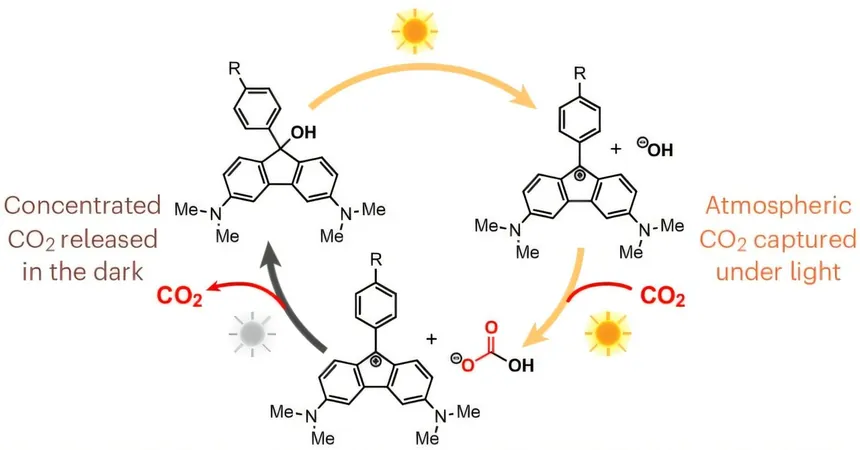
Revolutionary Breakthrough in Carbon Capture: Harnessing the Power of Sunshine to Trap CO₂!
2025-09-03
Author: Wei
Can Organic Molecules Save the Planet?
What if organic molecules could be the key to tackling some of Earth’s most pressing challenges? Assistant Professor Richard Y. Liu is on a mission to explore this captivating idea as he advances organic chemistry to create cleaner products and innovative solutions for climate change.
Solar-Powered CO₂ Trapping!
In his latest groundbreaking research published in *Nature Chemistry*, Liu has unveiled an exciting discovery: a unique class of organic molecules activated by sunlight, known as "photobases." These molecules generate hydroxide ions that efficiently and reversibly capture carbon dioxide (CO₂), marking a monumental leap towards scalable, low-energy methods for reducing greenhouse gas emissions.
Liu emphasizes the novelty of his work, citing it as a groundbreaking approach to utilizing light directly as an energy source for the molecular capturing process.
A Passion Ignited in the Chemistry Lab
Liu’s journey into the world of organic chemistry began during his time at Harvard College, where he initially envisioned a future in physics. However, a spark of curiosity ignited his passion for chemistry, leading him to create complex molecules in the lab. Under the mentorship of Ted Betley, he discovered his true calling—designing and assembling intricate molecular structures.
Leading the Charge at MIT and Beyond
During his doctoral studies at MIT, Liu collaborated with the renowned Stephen Buchwald to develop innovative copper and palladium catalysts, enhancing the synthesis of complex molecules from accessible materials. Today, as the head of his own lab in the Department of Chemistry and Chemical Biology, Liu tackles challenges across organic, inorganic, and materials chemistry.
He’s focusing on harnessing inexpensive and abundant nonmetals to achieve chemical reactions typically associated with metals.
Real-World Applications for a Sustainable Future
But Liu's work isn’t just theoretical; it’s designed for real-world impact. His lab is actively creating new organic materials for energy storage and catalysis, including innovative molecules capable of capturing and activating greenhouse gases.
This recent advancement in direct air capture is the result of a collaboration with Daniel G. Nocera, symbolizing Liu's commitment to practical solutions for climate challenges.
A Bright Future Powered by Innovation
Liu is optimistic about the potential of his research: "Direct air capture is among the most critical emerging climate technologies, but current methods are too energy-intensive. Our strategy of designing sunlight-activated molecules demonstrates a pathway towards a more efficient, potentially solar-powered future for CO₂ capture."
Team Collaboration: The Heart of Innovation
A diverse team of chemists, materials scientists, and engineers fuels Liu's lab, each member bringing unique expertise that allows for the exchange of groundbreaking ideas. Liu believes that this interdisciplinary collaboration is essential for tackling complex scientific questions.
Investing in Future Scientists
An integral part of Liu's mission is to educate the next generation of scientists. He envisions the research conducted in his lab not just as a means for individual advancement, but as a platform to empower students to achieve their Ph.D. and launch successful careers.
Funding Challenges Ahead?
However, Liu voices concerns regarding recent disruptions in federal funding, which he views as a significant threat to ongoing research.
He asserts that university-driven research ultimately benefits society, stressing that their discoveries aim to be publicly accessible rather than profit-driven.
As Liu and his team continue to push the boundaries of science, the hope is for their innovations to contribute significantly to the global fight against climate change.



 Brasil (PT)
Brasil (PT)
 Canada (EN)
Canada (EN)
 Chile (ES)
Chile (ES)
 Česko (CS)
Česko (CS)
 대한민국 (KO)
대한민국 (KO)
 España (ES)
España (ES)
 France (FR)
France (FR)
 Hong Kong (EN)
Hong Kong (EN)
 Italia (IT)
Italia (IT)
 日本 (JA)
日本 (JA)
 Magyarország (HU)
Magyarország (HU)
 Norge (NO)
Norge (NO)
 Polska (PL)
Polska (PL)
 Schweiz (DE)
Schweiz (DE)
 Singapore (EN)
Singapore (EN)
 Sverige (SV)
Sverige (SV)
 Suomi (FI)
Suomi (FI)
 Türkiye (TR)
Türkiye (TR)
 الإمارات العربية المتحدة (AR)
الإمارات العربية المتحدة (AR)